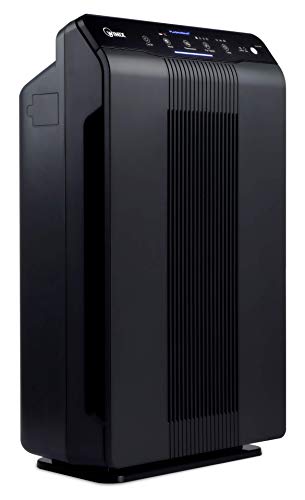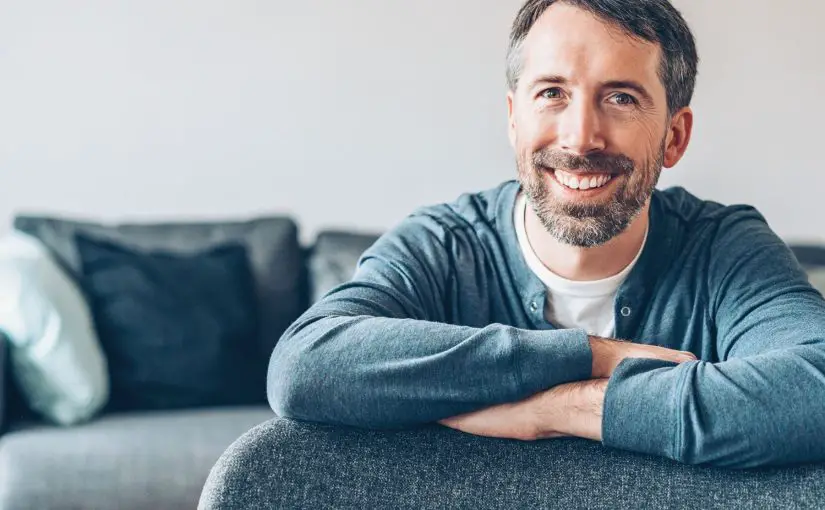Air ionizers/ionic air purifiers are popular appliances for indoor air quality.
But they do come with a few side effects that have put them under scrutiny and have given a few people misgivings about them.
Table of Contents
What are the Side Effects of an Air Purifier with Ionizer?
Air ionizers, a key technology in modern air purifiers, offer significant benefits for indoor air quality by electrically charging air molecules to attract and neutralize pollutants.
They excel in removing fine particulates, neutralizing airborne bacteria and viruses, and operate quietly without the need for filters.
However, a notable side effect is the production of trace amounts of ozone, a lung irritant that can exacerbate respiratory conditions like asthma.
While innovations in air purification technology continue to evolve, addressing these concerns, the balance between benefits and side effects of ionizers remains a crucial consideration.
Discover more about how these technologies work and their implications for your indoor environment in the following sections.
 Introduction
Introduction
Indoor air quality has become a growing concern in recent decades.
As modern buildings are constructed to be more airtight and energy efficient, indoor air pollution, as some have argued, has become a bigger issue than ever before.
Additionally, we spend more time indoors engaged in activities like watching TV, staring at the phone, and working on our laptops.
So it is no mystery that air purifiers have surged in popularity for home and business use.
One type of air purifying technology that has seen widespread adoption are air ionizers, also known as ionic air purifiers.
Ionic air purifiers work by electrically charging and emitting ions. The ions because of polarity attach and cluster together, bonding around whatever pollutants happen to be in the air.
And then because of the weight of the newly clustered particles, they fall out of the air.
 Ionic air purifiers do have several advantages:
Ionic air purifiers do have several advantages:
- They do not require Filters.
Not a small detail. Air purifiers probably more than any other require a back end investment of buying and replacing filters. - Quiet.
Don’t overlook this one either. Hepa filter air purifiers can be compared to running a loud fan. Ionizers usually have a fan about the size of a computer fan it at all. - Effective at removing fine particulates and neutralizing airborne bacteria and viruses. Ionic air purifiers that use advance technologies like Plasma wave and PCO(more about these later) actually destroy germs other than just filtering them.
Ionic Air Purifier Negative Side Effects
However, ionic air purifiers have also faced scrutiny for their potential downsides.
Mainly, the ionization process that is used produces trace amounts of ozone, which can irritate lungs and worsen respiratory illnesses like asthma.
Used improperly in confined indoor spaces, ionic purifiers can generate unsafe ozone levels.
As a result, The US Environmental Protection Agency (EPA) has placed restrictions on air purifiers that manufacture ozone.
The federal limit for ozone emissions from air purifiers, as of April 2023, requires that indoor air cleaning devices emit no more than 0.05 parts per million (ppm) of ozone.
The California Air Resources Board (CARB) bans the sale of ozone generators for use in indoor environments.
And just a cheeky gander around Amazon’s search results for air purifiers, you can see that ionic air purifiers are not nearly as popular as they once were.
Air Purifier Ozone Emission Levels
| Air Purifier Type | Ozone Emission Levels (ppm) |
|---|---|
| Basic Ionizers | 0.04 |
| Advanced Ionizers | 0.02 |
| Ionic/HEPA Combination | 0.01 |
| PCO Air Purifiers | 0.03 |
| EPA Safety Threshold | 0.05 |
Understanding Ozone Emission Levels in Context
The table above illustrates the ozone emission levels for various types of air purifiers, underscoring the importance of using an appropriately sized unit for your space.
It’s crucial to remember that these figures assume the air purifier is correctly matched to the room size. For instance, a PCO air purifier designed for a 1000 square feet area would be excessive and potentially problematic in a small 100 square feet room.
Oversizing can lead to unnecessarily high ozone levels, defeating the purpose of safe and effective air purification.
Therefore, selecting an air purifier that is appropriate for your room size not only optimizes performance but also ensures adherence to safety guidelines regarding ozone emissions.
Air Purifier Technologies Comparison
| Technology | Effectiveness | Target Pollutants | Noise Level | Maintenance Requirement | Ozone Production | Cost |
|---|---|---|---|---|---|---|
| Ionizers | Moderate to High | Particulates, Bacteria, Viruses | Quiet | Low (No filters) | Low to Moderate | Moderate |
| HEPA Filters | High | Particulates, Allergens | Moderate | High (Regular filter changes) | None | High |
| Activated Carbon | Moderate | Gases, Odors | Low to Moderate | Moderate | None | Moderate to High |
| Plasma Wave | High | Particulates, Bacteria, Viruses, VOCs | Quiet | Low | None | High |
| Photocatalytic Oxidation | High | VOCs, Bacteria, Viruses, Odors | Quiet | Moderate (UV light replacement) | Low | High |
 Air Oasis iAdapt
Air Oasis iAdapt
Click Here For Price
Combination Technology Air purifiers
Though you may not see as many straight up air ionizers and ionic air purifiers, you can find quite a few combination devices that seek to offer you the best of both worlds.
HEPA filter air purifiers are known for their capacity to capture air particles as small as .03 microns. HEPA 13 can’t even capture particulates as small as .01 microns.
You can argue that with those kinds of results why would you even want to mess with an ionizer, since there is the potential danger of ozone building up.
But actually, HEPA filters and ion generators make a good marriage.
How so?
The ionic side of the air purifier clusters the particles in the air together which makes them easier to be captured by the HEPA filter.
And since you’re not relying on the ions themselves as the main source of air purification, you can get the same clumping together effect by running the ionizer on low, which will lower the risk of ozone building up immensely.
Additionally, pairing ionizers with other filtration technologies like activated carbon can broaden the range of pollutants removed. Activated carbon adsorbs gases and odors that ionizers do not capture.
Reme Halo Induct Air Purifier
Click Here For More Info

Induct Ionic Air Purifiers
Installing the ionizer in the HVAC system treats air throughout the entire building while keeping ozone safely contained and rapidly dissipated.
Using Ionizers In the ductwork also helps avoid the high pressure drop caused by dense HEPA filters.
Using ionizers in the ductwork is a much more effective way of cleaning the air than using a dense HEPA filter in the HVAC, which can result in a high pressure drop.
Smart Multi-Tech Air Purifiers
Smart multi-technology air purifiers use sensors that can adjust ionizer settings automatically based on air quality conditions to minimize ozone production.
This smart integration points to the future of air cleaning technology.
Winix 5500-2 with Plazmawave – Click Here to View

Advanced Ionic Technologies:
Plasma Wave Technology
Plasma Wave technology is an innovative air purification method that employs bipolar ionization.
This process generates both positive and negative ions, which are dispersed into the air and effectively neutralize a wide range of airborne pollutants, including viruses, bacteria, mold, and allergens.
What makes Plasma Wave particularly appealing is its ability to purify the air without producing harmful ozone, making it a safer choice for indoor environments.
Winix is using Plasma Wave across a whole range of their products. Their 5500-2 model remains one of the most popular air purifiers sold on Amazon.
Air Oasis is another brand that is integrating plasma wave into their air purifiers smartly.
Photocatalytic Oxidation (PCO)
Photocatalytic Oxidation, using a titanium dioxide-coated filter activated by UV light, creates hydroxyl radicals to decompose organic pollutants in the air.
This technology, notably developed and employed by NASA for air purification in space shuttles and the International Space Station, effectively reduces harmful airborne chemicals, odors, bacteria, and viruses.
It’s now widely used in various industries, including healthcare, food processing, and commercial buildings, for its ability to transform contaminants into harmless substances, enhancing indoor air quality.
Photocatalytic oxidation was one of the most popular types of air purification only a few years ago. Unfortunately, the technology lost a lot of steam due to California’s ban on ozone generating devices.
But it still remains one of the best air purification technologies.
You can find it being used by RGF, Guardian Technologies, and AirPura to name a few.
Diverse Industrial Applications
Another point that adds to the validity of ionic technologies in air purification, is the extensive way it is being used in other industries.
You can find Plasma Wave and PCO (photo catalytic oxidation) being utilized in:
- Healthcare Facilities: Ensuring sterile environments in hospitals and clinics.
- Food Processing and Storage: Preserving food freshness and preventing spoilage.
- Commercial Buildings: Improving indoor air quality in offices, malls, and hotels.
- Manufacturing and Industrial Sites: Controlling pollutants and chemical emissions.
- Transportation: Enhancing air quality in vehicles, aircraft, and marine vessels.
- HVAC Systems: Integrated into larger systems for improved air quality in buildings.
- Agricultural Applications: Managing air quality in greenhouses and animal rearing facilities.
Conclusion
In conclusion, air ionizers and ionic air purifiers represent a significant step forward in our quest for cleaner indoor air.
While they offer numerous benefits such as filterless operation, quietness, and efficiency in removing fine particulates and neutralizing airborne pathogens, it’s crucial to weigh these advantages against the potential side effects, particularly the production of ozone.
Advances in air purification technology, including combination devices and smart multi-tech purifiers, are continuously evolving to mitigate these concerns and enhance indoor air quality.
As we move forward, understanding and leveraging these technologies in a safe and effective manner will remain paramount for healthier indoor environments.
FAQ
1. What are air ionizers?
Air ionizers are devices that use electrical charging to produce ions, which attach to and neutralize airborne pollutants.
2. How do air ionizers purify the air?
They electrically charge air molecules, causing pollutants to cluster and fall out of the air due to increased weight.
3. What are the benefits of using an air ionizer?
They are effective at removing fine particulates, neutralizing airborne bacteria and viruses, and operate quietly without filters.
4. What is a significant side effect of air ionizers?
They can produce trace amounts of ozone, a lung irritant that may worsen respiratory conditions like asthma.
5. What are the federal limits for ozone emissions from air purifiers?
As of April 2023, the limit is no more than 0.05 parts per million (ppm) of ozone.
6. How do combination air purifiers work?
They combine ionizers with other technologies like HEPA filters and activated carbon to enhance air purification.
7. Can ionizers be used in HVAC systems?
Yes, they can be installed in HVAC systems to treat air throughout a building while containing ozone.
8. What is smart multi-tech air purification?
It involves purifiers using sensors to adjust ionizer settings based on air quality, minimizing ozone production.
9. What is Plasma Wave technology?
Plasma Wave employs bipolar ionization to generate ions that neutralize pollutants without producing harmful ozone.
10. What is Photocatalytic Oxidation (PCO)?
PCO uses a titanium dioxide-coated filter and UV light to create radicals that decompose organic pollutants in the air.


 Ionic air purifiers do have several advantages:
Ionic air purifiers do have several advantages: